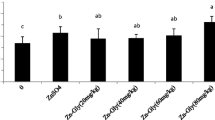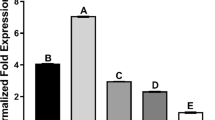Abstract
The study was carried out to evaluate the effect of Zn-Gly supplementation on the selected antioxidative enzymes and on the mineral composition in the liver and faeces as well as the biochemical and haematological parameters of chicken blood. Two hundred and fifty-one-day-old Ross 308 male broiler chicks were randomly allotted to five dietary treatments, each of which was replicated five times (10 birds in each cage). Five experimental groups were formed: control negative (CN)—without Zn, control positive supplemented with 100 mg ZnO, and three groups supplemented with 100, 50, and 25 mg Zn-Gly. An increase (P < 0.05) was recorded in the concentration of Cu and Zn in chicken livers after Zn-Gly supplementation, irrespective of the level of supply with the diet. The addition of 100 mg·Zn-Gly improved the activity of SODCuZn (P < 0.05) and reduced the MDA value (P < 0.05) in chicken livers. The addition of 100, 50, and 25 mg Zn-Gly reduced the concentration of zinc in the birds’ droppings, compared to the CN and 100 mg ZnO group. Zn-Gly at the level of 50 mg increased the concentration of Cu and Ca in chicken blood. The results indicate that the addition of Zn-Gly increased the antioxidative capacity of the body and storage of Zn and Cu in the liver; it also reduced the amount of Zn excreted with faeces. Zn-Gly can be an alternative to ZnO in providing a good source of Zn to enrich feed mixtures for broilers.
Similar content being viewed by others
References
Chasapis CT, Loutsidou AC, Spiliopoulou CA, Stefanidou ME (2012) Zinc and human health: an update. Arch Toxicol 86(4):521–534
Oteiza PI (2012) Zinc and the modulation of redox homeostasis. Free Radic Biol Med 53(9):1748–1759
Park SY, Birkhold SG, Kubena LF, Nisbet DJ, Ricke SC (2002) Review on the role of dietary zinc in poultry nutrition, immunity, and reproduction. Biol Trace Elem Res 101:147–163
Carlson MS, Boren CA, Wu C, Huntington CE, Bollinger DW, Veum TL (2004) Evaluation of various inclusion rates of organic zinc either as a polysaccharide or proteinate complex on the growth performance, plasma, and excretion of nursery pigs. J Anim Sci 82:1359–1366
Meyer TA, Lindemann MD, Cromwell GL, Monegue HJ, Inocencio N (2002) Effects of pharmacological levels of zinc as zinc oxide on fecal zinc and mineral excretion in weanling pigs. Prof Anim Sci 18:162–168
NRC (1994) Nutrient requirements of poultry, 9th edn. Natl. Acad. Press, Washington, DC
Burrell AL, Dozier WA, Davis AJ, Compton MM, Freeman ME, Vendrell PF, Ward TL (2004) Responses of broilers to dietary zinc concentrations and sources in relation to environmental implications. Br Poult Sci 45:255–263
El-Husseiny OM, Hashish SM, Ali RA, Arafa SA, Abd El-Samee LD, Olemy AA (2012) Effects of feeding organic zinc, manganese and copper on broiler growth, carcass characteristics, bone quality and mineral content in bone, liver and excreta. Int J Poult Sci 11:368–377
Salim HM, Lee HR, Jo C, Lee SK, Lee BD (2012) Effect of sex and dietary organic zinc on growth performance, carcass traits, tissue mineral content, and blood parameters of broiler chickens. Biol Trace Elem Res 147(1–3):120–129. doi:10.1007/s12011-011-9282-8
Moghaddam HN, Jahanian R (2009) Immunological responses of broiler chicks can be modulated by dietary supplementation of zinc-methionine in place of inorganic zinc sources. Asian Aust J Anim Sci 22(3):396–403
Kratzer FH, Vohra P (1986) Chelates in nutrition. CRC, Boca Raton
Feng J, Ma WQ, Niu HH, Wu XM, Wang Y, Feng J (2010) Effects of zinc glycine chelate on growth, hematological, and immunological characteristics in broilers. Biol Trace Elem Res 133:203–211
Osaretin ATE, Gabriel A (2008) Akande. Effect of zinc deficiency on memory, oxidative stress and blood chemistry in rats. Adv Med Dent Sci 2:74–82
Ozturk A, Baltaci AK, Mogulkoc R, Oztekin E, Sivrikaya A, Kurtoglu E, Kul A (2003) Effects of zinc deficiency and supplementation on malondialdehyde and glutathione levels in blood and tissue of rats’ performance swimming exercise. Biol Trace Elem Res 94:157–166
Farombi EO, Hansen M, Raven-Haren G, Moller P, Dragsted LO (2004) Commonly consumed and naturally occurring dietary substances affect biomarkers of oxidative stress and DNA damage in the healthy rats. Food Chem Toxicol 2:15–22
Kwiecień M, Winiarska-Mieczan A, Valverde Piedra JL, Bujanowicz-Haraś B, Chałabis-Mazurek A (2015a) Effects of copper glycine chelate on selected parameters carcasses, liver and fecal mineral concentrations, haematological and biochemical blood parameters in broilers. Agric Food Sci 24:92–103
Kwiecień M, Samolińska W, Bujanowicz-Haraś B (2015b) Effects of iron glycine chelate on growth, carcass characteristic, liver mineral concentrations and haematological and biochemical blood parameters in broilers. J Anim Physiol Anim Nutr 99:1184–1196. doi:10.1111/jpn.12322
Watkins S (2008) Water: identifying and correcting challenges. Avian Advice 10:10–15
Aviagen (2013) Ross 308 Broiler. Nutrition Specification. www.aviagen.com
Ziołecki J, Doruchowski W (1989) Evaluation method of poultry slaughter value. Publishing house COBRD Poznań(In Polish)
AOAC (2000) Official methods of analysis. Intern, 17th edn. AOAC Inter., Gaithersburg
Polish Norm, (1976) 76/R-64781. Feed. Determination of phosphorus content
Kussaibat R, Leclercq B (1985) A simplified rapid method for the determination of apparent and true metabolizable energy values of poultry feed. Arch Geflugelkunde 49:54–62
Misra HP, Fridowich I (1972) The role of superoxide anion in the autoxidation of epinephrine and a simple assay for superoxide dismutase. J Biol Chem 247:3170–3175
Sinha AK (1972) Colorimetric assay of catalase. Anal Biochem 47:389–394
Winiarska-Mieczan A (2013) Protective effect of tannic acid on the brain of adult rats exposed to cadmium and lead. Environ Toxicol Pharmacol 36:9–18
Campbell TW (1995) Avian hematology and cytology, 2nd edn. Iowa State University Press, Ames
Drabkin DR (1945) Crystallographic and optical properties of human hemoglobin. A proposal for the standardization of hemoglobin. Am J Med Sci 209:268–270
Friedewald WT, Levy RI, Frederickson DS (1972) Estimation of the concentration of low-density lipoprotein cholesterol in plasma, without use of the preparative ultracentrifuge. Clin Chem 18:499–502
StatSoft (2013) Statistica ver. 10 (data analysis software system). StatSoft, Tulsa www.statsoft.com
Feeding Standards for Poultry (2005) Nutritional recommendations and nutritive value of feeds for poultry. Smulikowska S., PAN, IFiZZ im. J. Kielanowskiego, Warszawa in Polish
Brzóska F, Brzeziński W, Brzóska B (2003) Mineral nutrients in Polish feedingstuffs. Part 2. Cereal grains. Ann Anim Sci 3:311–321
Szatanik-Kloc A, Bowanko B (2007) Wpływ pH i jonów cynku na powierzchnię właściwą korzeni żyta (Secale cereale L.) wyznaczaną metodą adsorpcji-desorpcji azotu. Acta Agrophysica 10(3):705–713
Pisulewska E, Zając T, Oleksy A (1998) The mineral composition of selected varieties of triticale under different nitrogen fertilization. Biul IHAR 205/206:179–188 (in Polish)
Bednarek W, Tkaczyk P, Dresler S (2008) Heavy metal content as a criterion for assessing the quality of winter wheat grain. Acta Agrophysica 12(2):315–326 (in Polish)
Kaszubkiewicz J, Kawałko D (2009) Heavy metal content in soils and plants in the district of Jelenia Góra. Ochr Środ Zas Natur 40:177–189 (in Polish)
Ma W, Niu H, Feng J, Wang Y, Feng J (2011) Effects of zinc glycine chelate on oxidative stress, contents of trace elements, and intestinal morphology in broilers. Biol Trace Elem Res 142:546–556
Shaheen AA, El-Fattah AA (1995) Effect of dietary zinc on lipid peroxidation, glutathione, protein thiols leves and superoxide dismutase activity in tissues. Int J Biochem Cell Biol 27:89–95
Pathak A, Mahmood A, Pathak R, Dhawan D (2002) Effect of zinc on hepatic lipid peroxidation and antioxidative enzymes in ethanol-fed rats. J Appl Toxicol 22:207–210
McClain CJ, Le S (1983) Zinc deficiency in the alcoholic alcoholism. Winters Press, New York, 7:5–10
Dozier WA, Davis AJ, Freeman ME, Ward TL (2003) Early growth and enviromental implications of dietary zinc and copper concentrations and sources of broiler chicks. Br Poult Sci 44:726–731
Yalçınkaya İ, Çınar M, Yıldırım E, Erat S, Başalan M, Güngör T (2012) The effect of prebiotic and organic zinc alone and in combination in broiler diets on the performance and some blood parameters. Ital J Anim Sci 11:289–302
Akbari MR, Kermanshahi H, Moghaddam HN, Moussavi ARH, Afshari JT (2008) Effects of wheat-soybean meal based diet supplementation with vitamin A, vitamin E and zinc on blood cells, organ weights and humoral immune response in broiler chickens. J Anim Vet Adv 7(3):297–304
Nagalakshmi D, Sridhar K, Parashuramulu S (2015) Replacement of inorganic zinc with lower levels of organic zinc (zinc nicotinate) on performance, hematological and serum biochemical constituents, antioxidants status, and immune responses in rats. Vet World 8(9):1156–1162
Sridhar K, Nagalakshmi D, Rao SVR (2015) Effect of graded concentration of organic zinc (zinc glycinate) on skin quality, hematological and serum biochemical constituents in broiler chicken. Indian J Anim Sci 85:643–648
Uyanık F, Eren M, Atasever A, Tunçoku G, Kolsuz AH (2001) Changes in some biochemical parameters and organs of broilers exposed to cadmium and effect of zinc on cadmium induced alterations. Isr J Vet Med 56:128–134
Salgueiro MJ, Krebs N, Zubillaga MB, Weill R, Postaire E, Lysionek AE, Caro RA, De Paoli T, Hager A, Boccio J (2001) Zinc and diabetes mellitus. Biol Trace Elem Res 81:215–228
Bülbül T, Küçükersan S (2004) The effect of addition of organic and inorganic zinc on egg production, egg quality and some blood parameters in laying hens rations. Vet Bilimleri Dergisi 20(4):53–60
Aksu DS, Aksu T, Őzsoy B (2010) The effects of lower supplementation levels of organically complexed minerals (zinc, copper and manganese) versus inorganic forms on hematological and biochemical parameters in broiler. Kafkas Univ Vet Fak Derg 16(4):533–559
Kaya S, Kececi T, Haliloglu S (2001) Effects of zinc and vitamin A supplements on plasma levels of thyroid hormones, cholesterol, glucose and egg yolk cholesterol of laying hens. Res Vet Sci 7:135–139
Sahin K, Smith MO, Onderci M, Sahin N, Gursu MF, Kucuk O (2005) Supplementation of zinc from organic or inorganic source improves performance and antioxidant status of heat-distressed quail. Poult Sci 84:882–887
Parák T, Straková E (2011) Zinc as a feed supplement and its impact on plasma cholesterol concentrations in breeding cocks. Acta Vet Brno 80:281–285
Kaneko JJ, Harvey JW, Bruss ML (2008) Clinical biochemistry of domestic animals, 6th edn. Elsevier, Academic Press, Burlington
Acknowledgment
This work was financially by the project NN 311543540 from the Ministry of Science and Higher Education, Poland. The authors wish to thank ARKOP Sp. z o.o. (Bukowno, Poland) for providing the necessary organically complexed iron (Glystar Forte Zn) to carry out this experiment.
Author information
Authors and Affiliations
Corresponding author
Ethics declarations
Conflict of Interest
There are no known conflicts. Financial support for this work does no influence its outcome.
The manuscript has been read and approved by all named authors and that there are no other persons who satisfied the criteria for authorship but are not listed. The order of authors listed in the manuscript has been approved by all authors.
Rights and permissions
About this article
Cite this article
Kwiecień, M., Winiarska-Mieczan, A., Milczarek, A. et al. Biological Response of Broiler Chickens to Decreasing Dietary Inclusion Levels of Zinc Glycine Chelate. Biol Trace Elem Res 175, 204–213 (2017). https://doi.org/10.1007/s12011-016-0743-y
Received:
Accepted:
Published:
Issue Date:
DOI: https://doi.org/10.1007/s12011-016-0743-y




